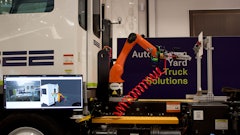
Over the past three years, various industries have experienced significant disruptions, with the fleet management sector being no exception. The confluence of factors such as the COVID-19 pandemic, supply chain disruptions, shifting labor patterns and the rapid evolution of technology have left an indelible mark on fleet management. To thrive in this new landscape, companies have had to adapt to unpredictable fuel prices, increasingly complex insurance processes and mounting repair costs. However, what truly sets apart forward-thinking companies is their embrace of technology, especially Artificial Intelligence (AI).
It's increasingly evident that AI will significantly impact virtually every industry. When considering its impact on the supply chain, it becomes apparent that effective fleet management and optimization are at the forefront of leveraging this emerging technology.
The Imperative of Fleet Optimization
The modern fleet executive faces a myriad of challenges daily, including load availability, driver assignments, equipment specifications, operational costs, compliance with regulations and more. In a world where agility and efficiency are paramount, optimizing fleet operations is not merely an advantage but a survival strategy.
The advantages of fleet optimization are manifold, ranging from enhanced asset utilization and data-driven decision-making to efficient load planning and substantial cost savings. In a time where efficiency spells profitability, optimization offers a lifeline to fleet managers. Reduced empty miles and improved customer service further contribute to the overall profitability of fleet operations.
The Role of AI in Fleet Optimization
Artificial Intelligence, often dubbed as AI, plays a pivotal role in the ongoing transformation of fleet management. By leveraging AI, supply chain executives can streamline operations, automate time-consuming tasks and drive substantial cost savings. Here is the ways AI is reshaping fleet optimization:
Data Collection: AI enables software tools to collect data from every asset and consolidate it into a single source of truth. It gathers data from various sensors on each vehicle, including the transmission, engine, cab systems and tires. The challenge lies in analyzing and using this vast amount of data. AI tools can sift through this data, identify actionable insights and offer recommendations for optimizing fleet operations.
Data Analysis: Connected vehicles generate substantial amounts of data, up to 25GB per hour per vehicle according to McKinsey & Company. AI can process and analyze this data, providing fleet managers with actionable insights. By using AI algorithms, fleet managers can sift through the data to pinpoint areas for improvement.
Management Tasks: AI enables the automation of basic management and administrative tasks. For instance, when AI identifies that a vehicle requires a specific service, it can automatically schedule the service, reassign the driver to another vehicle and provide a digital key for operation.
Processes: As fleet managers become comfortable with automating preventive and predictive maintenance, they can start automating larger-scale strategies to further reduce downtime, improve efficiency, and maximize revenue. Automation can encompass warranty tracking, emissions testing, license and registration, driver monitoring programs and fuel usage patterns, among others.
Automating Maintenance: A crucial aspect of AI-driven fleet optimization is the focus on vehicle health and uptime. Automation can be applied to both preventive and predictive maintenance. Preventive maintenance cycles can be automated based on actual vehicle usage, ensuring that maintenance activities are performed when needed rather than following arbitrary mileage or time-based schedules. Predictive maintenance goes a step further, using aggregated vehicle data and AI algorithms to proactively predict parts failures. This early identification allows fleets to schedule repairs before components fail, reducing downtime and improving overall efficiency.
Deciding What to Automate: The journey of automation begins with identifying the right tasks to automate. Fleet managers should look for opportunities to automate low-hanging fruit, tasks that can provide immediate benefits and reduce manual workloads. These could include automated scheduling for tire repairs or streamlining driver assignments based on vehicle conditions. Automation, however, should be an intentional process, starting with clear goals and a focus on efficiency.
Automation is a Journey, Not a Destination: It's essential to understand that automation is an ongoing process, not a one-time destination. Supply chain executives should continually identify areas for improvement and implement automation where it makes sense. The integration of AI-driven solutions promises not only improved efficiency but also a brighter future for fleet management in the AI era.
In conclusion, fleet optimization in the AI era is transforming the way fleet management operates. AI-driven technologies are streamlining operations, reducing costs and enhancing overall efficiency. The journey of automation is ongoing, and supply chain executives who harness the power of AI can look forward to a future of smarter, more efficient and more profitable fleet management.


























